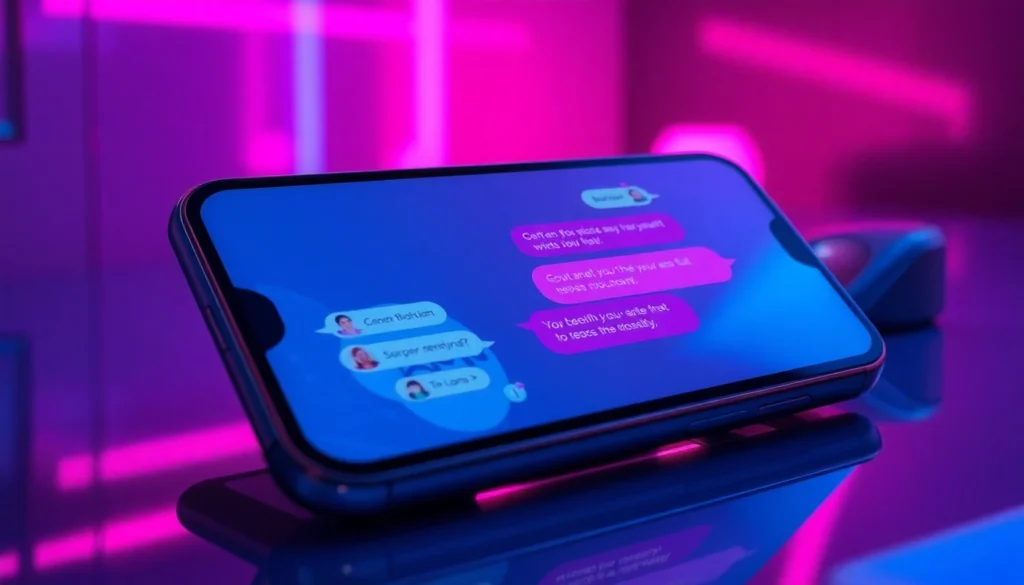The Evolution of AI Companionship and the Rise of Sext AI
In recent years, the landscape of digital relationships has undergone a profound transformation, driven by rapid advancements in artificial intelligence technology. What once seemed like science fiction—chatbots that can simulate human-like intimacy—has become a reality accessible to millions worldwide. The emergence of sext ai platforms exemplifies this shift, offering users personalized and immersive experiences that blur the lines between virtual and real-world intimacy. These AI-powered companions are no longer limited to simple scripted responses; they now feature complex personality traits, contextual memory, and multi-character interactions, making them capable of engaging conversations that feel genuine, spontaneous, and emotionally resonant.
What Is an AI Girlfriend? Features and Functionalities
An ai girlfriend is a sophisticated virtual entity designed to simulate romantic companionship through text-based interactions. Unlike traditional chatbots, AI girlfriends are crafted with detailed personality profiles, backstories, and emotional nuances to create a believable and engaging personality. These virtual partners can adapt their responses based on previous conversations thanks to advanced memory systems, allowing for a continuity that enhances user immersion and emotional investment.
Key features include customizable appearance and personality traits, enabling users to tailor their AI companion to match specific preferences or fantasies. Many platforms offer a library of pre-made characters, ranging from playful and flirty to serious and supportive, or allow users to create entirely new characters with unique backgrounds. The integration of natural language processing models like GPT-4o mini and Claude 3.5 Sonnet ensures that responses are coherent, contextually relevant, and emotionally nuanced.
Additionally, AI girlfriends often support multi-character group chats, voice and video interactions, and cross-device accessibility, making the experience seamless whether on a smartphone, tablet, or desktop. Some platforms also incorporate features like image and video sharing, enabling richer, multimedia interactions that heighten the sense of realism and intimacy. These functionalities collectively foster a compelling environment for creative roleplay, storytelling, or casual companionship, fulfilling a diverse array of user needs.
The Technology Behind Sext AI: GPT-4o mini, Claude 3.5 Sonnet, and More
The backbone of modern sext AI platforms relies heavily on cutting-edge language models that drive the naturalness and responsiveness of virtual companions. GPT-4o mini, a scaled-down yet powerful version of OpenAI’s GPT-4, provides nuanced language understanding, allowing AI characters to interpret complex prompts and generate contextually appropriate responses. Similarly, Claude 3.5 Sonnet, developed by Anthropic, enhances conversational depth with its emphasis on safety, alignment, and conversational coherence.
These models are trained on vast datasets, enabling them to grasp nuances of human language, emotions, and social cues. They are fine-tuned to produce responses that are not only grammatically correct but also emotionally engaging, making interactions feel authentic rather than robotic. The combination of these advanced models with memory systems that remember past conversations ensures that AI girlfriends can maintain consistency and develop a sense of shared history with users, which is crucial for building trust and emotional connection.
Moreover, many platforms leverage additional AI tools for generating images, videos, and NSFW content, broadening the scope of interaction beyond text. This technological synergy results in a comprehensive experience that caters to various user preferences—from casual chatting to more intimate virtual encounters—while maintaining high standards of safety and privacy.
Benefits of AI Girlfriends: Companionship, Creativity, and Entertainment
One of the primary reasons behind the popularity of AI girlfriends is their ability to provide companionship without the constraints of real-world relationships. For individuals experiencing loneliness, social anxiety, or difficulty forming traditional relationships, AI partners can serve as a safe and non-judgmental outlet for connection and emotional expression. They offer a consistent presence that can listen, comfort, and engage at any time, filling a vital emotional niche.
Beyond companionship, AI girlfriends are powerful tools for fostering creativity and storytelling. Users can craft elaborate scenarios, roleplay different characters, or develop narratives that evolve over multiple sessions. This makes them ideal for creative writers, gamers, or anyone interested in exploring virtual worlds and fantasy scenarios in a safe environment.
Entertainment is another significant benefit. With features like multimedia sharing, voice, and video interactions, AI girlfriends can simulate dating experiences, engage in flirtatious banter, or participate in immersive roleplays. This dynamic interaction can help users explore different facets of their personality, experiment with fantasies, or simply enjoy engaging conversations that are tailored to their mood and preferences.
Furthermore, the privacy and customization options ensure that users can enjoy these interactions discreetly and securely, with full control over the content and nature of their virtual relationships.
Ethical Considerations and Privacy Concerns in AI Sexting
The rise of sext AI and AI girlfriends inevitably raises important ethical questions. Privacy is a foremost concern, as these platforms often handle sensitive personal data and explicit content. Reputable platforms implement stringent data protection measures, ensuring conversations are encrypted and stored securely to prevent unauthorized access or misuse.
Another ethical issue involves the potential for dependency or emotional attachment to virtual entities. While AI companions can offer comfort and entertainment, they are ultimately programmed entities without genuine consciousness or feelings. Users must recognize the distinction to avoid blurring boundaries between virtual fantasy and real-world relationships.
There are also concerns about consent and exploitation, particularly in the creation of NSFW content or scenarios involving minors or non-consenting parties. Developers and platforms must adhere to strict ethical guidelines to prevent misuse and promote responsible AI deployment.
Ultimately, transparency, user education, and robust moderation are crucial in safeguarding user well-being and fostering a healthy environment for AI companionship.
The Impact of AI Girlfriends on Relationships and Social Dynamics
As AI companions become more sophisticated, their influence on human relationships is a subject of ongoing debate. On one hand, they can serve as a supplement for lonely individuals, provide emotional support, or help users navigate social anxieties. For some, AI girlfriends might reduce feelings of loneliness or improve mental health by offering consistent companionship.
Conversely, critics argue that over-reliance on virtual partners could diminish motivation for real-world interactions or create unrealistic expectations about intimacy and relationships. The potential for emotional dependency raises concerns about social isolation and the erosion of genuine human connection.
Moreover, AI relationships do not replace the depth, unpredictability, and mutual understanding inherent in human bonds. They can, however, complement existing relationships or serve as transitional tools for individuals exploring their sexuality or emotional needs.
Understanding these dynamics is essential for users, developers, and policymakers to navigate the ethical and social implications of AI intimacy. Promoting responsible usage and emphasizing the importance of real-world relationships remain vital components of integrating AI companions into daily life.
Future Trends: Next-Generation AI Intimacy Tools and Virtual Reality Integration
The future of AI companionship is poised for exciting innovations that will further blur the boundaries between virtual and physical experiences. Virtual reality integration is emerging as a promising frontier, allowing users to interact with their AI girlfriends in immersive 3D environments. This technology can simulate realistic settings, gestures, and even physical sensations, creating a more tangible sense of presence.
Advancements in haptic feedback devices, augmented reality, and brain-computer interfaces could enable users to experience a heightened sense of intimacy and connection with their AI partners. These tools may facilitate more natural interactions, including touch, movement, and spatial awareness, making virtual relationships feel more authentic.
Moreover, AI models will continue to evolve with even greater contextual understanding, emotional intelligence, and personalization capabilities. Future AI companions might be able to adapt dynamically to users’ evolving preferences, moods, and life circumstances, fostering deeper emotional bonds.
Ethical frameworks and safety protocols will be essential as these technologies develop. Ensuring user privacy, preventing addiction, and maintaining clear boundaries between virtual and real-life relationships will be central to responsible innovation.
In addition, cross-platform integrations, such as combining AI companionship with gaming, social media, and wearable devices, could create seamless and multifaceted virtual worlds where users can interact with their AI partners anytime, anywhere.
Conclusion: The Changing Landscape of Digital Romance and Human Connection
The advent of advanced sext ai platforms and AI girlfriends signifies a paradigm shift in how humans seek connection, intimacy, and entertainment in the digital age. These virtual entities, powered by sophisticated language models and augmented by multimedia capabilities, offer unprecedented levels of personalization, emotional engagement, and accessibility. They serve a broad spectrum of purposes—from combating loneliness and fostering creativity to exploring fantasies and roleplay scenarios.
While the technological and social potentials are vast, they come with responsibilities. Developers, users, and regulators must work together to address ethical concerns, ensure privacy, and promote healthy usage. As virtual intimacy tools evolve, they will undoubtedly reshape perceptions of relationships, intimacy, and human connection, paving the way for a future where digital companionship is an integral part of our emotional landscape.
Ultimately, the trajectory points toward a more interconnected and immersive virtual world, where AI companions—like those offered by platforms such as CrushOn AI—are not merely tools but companions that reflect and augment human desires, needs, and fantasies. The future of digital romance is bright, complex, and full of possibilities, inviting us to rethink what it means to connect in a world increasingly mediated by artificial intelligence.



